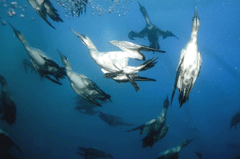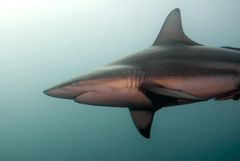Wild Coast
Air Date: Week of October 10, 2008

A close up of Gannets as they find a meal off Wild Coast. (Courtesy of Wild Ocean, Photo: Luke Cresswell)
Each spring along the southeastern tip of the African continent, a massive migration of sardines brings predators of all kinds together for a massive feeding frenzy. Steve McNicholas co-directed a three dimensional Imax film called “Wild Ocean” about the event.
Transcript
GELLERMAN: And now for some armchair adventure. Showing in IMAX theaters around the nation, is a new 3-D movie: Wild Ocean.
MOVIE VOICEOVER: There is a place where man still shares the ocean, where the food chain is still unbroken. This is where Africa meets the sea.
[MUSIC FROM FILM]
GELLERMAN: The KwaZulu-Natal Coastline—stretching from the east coast of South Africa to Mozambique, is the scene of an annual migration spectacle. Billions of sardines, driven towards the coast by warm ocean currents swarm in the sea, as sharks, seabirds, and dolphins wait.
“Wild Ocean” was co-directed by Steve McNicholas. You might know the English dancer-choreographer for his percussion theater troupe, Stomp. McNicholas traveled to South Africa to film another kind of choreography—and epic epic struggle for survival.
MCNICHOLAS: I was stunned. It was 2005, July, 2005, which is winter down there. And I was in a helicopter. We were scouting along the coast, so just taking photographs of the coast. And then I just saw this huge—it looked like—it honestly looked like an oil slick. I really thought there’d been some kind of spillage, because I’d actually just passed—there was a wreck of a tanker along the coast. But it was fish. It was this huge shoal of sardines that was really just a fraction of the shoal that was traveling along that coastline that was just swept into a little beach area. And they were literally coming up on to the sand on the beach. We landed the helicopter and went down and looked, and just this whole frenzy of people taking the sardines out of the water. The women going in with skirts and scooping sardines out in their skirts, people running in with buckets, taking fish out with buckets. And while all this is happening, you had—there was probably about twenty sharks moving in from the deeper water. So these sardines were truly doomed because on one hand you got the people on the beach who are going for them, you’ve got sharks in the water going for them and you’ve got gannets were coming in from above.

Men offloading sardines at Mossel Bay, Eastern Cape. (Courtesy of Wild Ocean, Photo: Steve McNicholas)
GELLERMAN: I gotta tell you, those gannets, those birds, they look like they’re dive bombing, they’re kind of dropping out the sky, going boom—head-first right into the water.
[MUSIC]
MCNICHOLAS: Oh, they’re incredible. I mean they plummet from 30, 40 foot in the air straight down into the ocean. And as you watch them, it’s almost like they dislocate their wings or they become a living dart so when they hit the water—their skulls are specially strengthened to be able to take that impact, so when they hit the water, they go as deep as they possibly can with the—you know, the force of gravity takes them.
GELLERMAN: How did you film that because youÂ’ve got them falling out of the sky and then you see them in the water as they hit, under water. Is it one camera or two?
MCNICHOLAS: We had multiple cameras on his project. Above water we used IMAX cameras, as much as we possibly could we shot with 3D IMAX camera. And the aerial shots are shot with 2D. So weÂ’re with the gannets in the helicopter above with an IMAX camera on the helicopter. WeÂ’ve got a boat with a 3D IMAX camera taking the gannets as they hit the water. And then under the water we were shooting in high definition, and again in 3D. It can get pretty hairy. ItÂ’s difficult, but the reason we wanted to shoot in 3D is because we knew the action with the sharks and the dolphins and the gannets, we knew in 3D that was going to be stunning.
GELLERMAN: The dolphins at one point are feasting on the sardines and it looks like the sea is boiling.
[DOLPHIN SOUNDS AND MUSIC]
GELLERMAN: And the music is matching this frenzy.
MOVIE VOICEOVER: The sea is alive with predators, unconcerned with each other, focused only upon taking the sardines from every conceivable direction. An undersea battle has begun.

A close up of Gannets as they find a meal off Wild Coast. (Courtesy of Wild Ocean, Photo: Luke Cresswell)
[MUSIC CONTINUES]
MCNICHOLAS: Well thatÂ’s the thing. We are divers who are first and foremost musicians so when weÂ’re working on the music what we want to do is create a score that made you, well, helped you to feel the emotions that you feel when youÂ’re actually there. Because it is a massive adrenaline rush to be, you know, surrounded by sharks and dolphins and this frenzy. Massive adrenaline rush.
[MUSIC CONTINUES]
GELLERMAN: DÂ’you ever feel afraid?
MCNICHOLAS: Yeah. It’s—you don’t belong there. You’re in someone else’s territory. And, for me, the one moment when I really felt nervous was actually in the helicopter and we were above a shark feeding frenzy and looking down into the water, and I just suddenly thought, if we were to ditch the helicopter now, there’s no escape. Those sharks were going absolutely crazy. And there was, maybe about sixty sharks, and all going absolutely crazy below me. And I also knew from stories along that coastline that when ever anyone does ditch, or if there’s a wreck there are generally—no bodies are usually found.
GELLERMAN: I guess you have the highest concentration of shark species there. YouÂ’ve got these dolphins, youÂ’ve got the people coming in from the land. This ecosystem is, really, extraordinary. And it all happens at this one time of year.
MCNICHOLAS: Yes. Well it all happens because of the cold water that is kind of thrusting northwards from the southern cape is kind of hemmed in to the coastline area from the warmer water coming in from the north. So what happens is that these fish get kind of forced in to these shallow waters very prematurely for them, because they wouldnÂ’t normally go into shallow water. And thatÂ’s why theyÂ’re kind of trapped. And thatÂ’s why so many predators are attracted to it. The thing that struck me though, is the more I read about it and the more I learned about it, I realized that what weÂ’re calling extraordinary, what weÂ’re calling a one-off event in the natural calendar, it used to happen on a much bigger scale than we witnessed in South Africa. It used to happen off both east and west coast America and basically we ate them all. We overfished.

A black tip shark passes by the camera. (Courtesy of Wild Ocean, Photo: Luke Cresswell)
GELLERMAN: At one point in your film the narrator asks, you know, what can we do to keep the oceans alive. You never answer that question in the film. Did you not want to be preachy?
MCNICHOLAS: I see what you mean. No, didn’t want to be preachy. You know that’s just not the way I’d like to go about it. I don’t preach in my personal life. You know, I really think that if people walk away and ask questions, I think that’s a bit better than hitting them over the head with a, you know, list of things that they must go and do. But, you know, there are so many things we can do, and there are so many things we can be positive about when it come to the ocean. For me, the point of the movie was: Look – over a hundred years ago, this kind of thing used to happen on a much bigger scale all over the world. Now think about that. If people walk out thinking ‘Wow, that’s an incredible experience and I can’t believe it used to happen just off the coast where I live.’ If they can come way with that message, then that’s, that’s a start.
[MUSIC]
GELLERMAN: Steve McNicholas, I want to thank you very much for joining us.
MCNICHOLAS: Thank you.
[MUSIC AND DOLPHIN SOUNDS]
GELLERMAN: Steve McNicholas is the co-director of the new IMAX 3D movie, “Wild Ocean”. For more information, go to our Web site, loe.org.
[MUSIC, DOLPHIN AND OCEAN SOUNDS]
Links
Living on Earth wants to hear from you!
Living on Earth
62 Calef Highway, Suite 212
Lee, NH 03861
Telephone: 617-287-4121
E-mail: comments@loe.org
Newsletter [Click here]
Donate to Living on Earth!
Living on Earth is an independent media program and relies entirely on contributions from listeners and institutions supporting public service. Please donate now to preserve an independent environmental voice.
NewsletterLiving on Earth offers a weekly delivery of the show's rundown to your mailbox. Sign up for our newsletter today!
 Sailors For The Sea: Be the change you want to sea.
Sailors For The Sea: Be the change you want to sea.
 The Grantham Foundation for the Protection of the Environment: Committed to protecting and improving the health of the global environment.
The Grantham Foundation for the Protection of the Environment: Committed to protecting and improving the health of the global environment.
 Contribute to Living on Earth and receive, as our gift to you, an archival print of one of Mark Seth Lender's extraordinary wildlife photographs. Follow the link to see Mark's current collection of photographs.
Contribute to Living on Earth and receive, as our gift to you, an archival print of one of Mark Seth Lender's extraordinary wildlife photographs. Follow the link to see Mark's current collection of photographs.
 Buy a signed copy of Mark Seth Lender's book Smeagull the Seagull & support Living on Earth
Buy a signed copy of Mark Seth Lender's book Smeagull the Seagull & support Living on Earth

